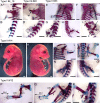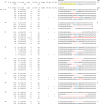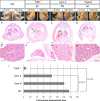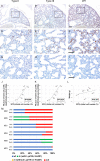Fgf10-CRISPR mosaic mutants demonstrate the gene dose-related loss of the accessory lobe and decrease in the number of alveolar type 2 epithelial cells in mouse lung
- PMID: 33057360
- PMCID: PMC7561199
- DOI: 10.1371/journal.pone.0240333
Fgf10-CRISPR mosaic mutants demonstrate the gene dose-related loss of the accessory lobe and decrease in the number of alveolar type 2 epithelial cells in mouse lung
Abstract
CRISPR/Cas9-mediated gene editing often generates founder generation (F0) mice that exhibit somatic mosaicism in the targeted gene(s). It has been known that Fibroblast growth factor 10 (Fgf10)-null mice exhibit limbless and lungless phenotypes, while intermediate limb phenotypes (variable defective limbs) are observed in the Fgf10-CRISPR F0 mice. However, how the lung phenotype in the Fgf10-mosaic mutants is related to the limb phenotype and genotype has not been investigated. In this study, we examined variable lung phenotypes in the Fgf10-targeted F0 mice to determine if the lung phenotype was correlated with percentage of functional Fgf10 genotypes. Firstly, according to a previous report, Fgf10-CRISPR F0 embryos on embryonic day 16.5 (E16.5) were classified into three types: type I, no limb; type II, limb defect; and type III, normal limbs. Cartilage and bone staining showed that limb truncations were observed in the girdle, (type I), stylopodial, or zeugopodial region (type II). Deep sequencing of the Fgf10-mutant genomes revealed that the mean proportion of codons that encode putative functional FGF10 was 8.3 ± 6.2% in type I, 25.3 ± 2.7% in type II, and 54.3 ± 9.5% in type III (mean ± standard error of the mean) mutants at E16.5. Histological studies showed that almost all lung lobes were absent in type I embryos. The accessory lung lobe was often absent in type II embryos with other lobes dysplastic. All lung lobes formed in type III embryos. The number of terminal tubules was significantly lower in type I and II embryos, but unchanged in type III embryos. To identify alveolar type 2 epithelial (AECII) cells, known to be reduced in the Fgf10-heterozygous mutant, immunostaining using anti-surfactant protein C (SPC) antibody was performed: In the E18.5 lungs, the number of AECII was correlated to the percentage of functional Fgf10 genotypes. These data suggest the Fgf10 gene dose-related loss of the accessory lobe and decrease in the number of alveolar type 2 epithelial cells in mouse lung. Since dysfunction of AECII cells has been implicated in the pathogenesis of parenchymal lung diseases, the Fgf10-CRISPR F0 mouse would present an ideal experimental system to explore it.
Conflict of interest statement
Supported by an academic grant from Pfizer Japan, Inc. This does not alter our adherence to PLOS ONE policies on sharing data and materials.
Figures






Similar articles
-
Highly efficient targeted mutagenesis in one-cell mouse embryos mediated by the TALEN and CRISPR/Cas systems.Sci Rep. 2014 Jul 16;4:5705. doi: 10.1038/srep05705. Sci Rep. 2014. PMID: 25027812 Free PMC article.
-
Fgf10 deficiency is causative for lethality in a mouse model of bronchopulmonary dysplasia.J Pathol. 2017 Jan;241(1):91-103. doi: 10.1002/path.4834. Epub 2016 Nov 26. J Pathol. 2017. PMID: 27770432 Free PMC article.
-
Fgf10 dosage is critical for the amplification of epithelial cell progenitors and for the formation of multiple mesenchymal lineages during lung development.Dev Biol. 2007 Jul 15;307(2):237-47. doi: 10.1016/j.ydbio.2007.04.033. Epub 2007 May 3. Dev Biol. 2007. PMID: 17560563 Free PMC article.
-
Use of CRISPR/Cas9 gene-editing tools for developing models in drug discovery.Drug Discov Today. 2018 Mar;23(3):519-533. doi: 10.1016/j.drudis.2018.01.014. Epub 2018 Jan 8. Drug Discov Today. 2018. PMID: 29326075 Review.
-
Challenges of in vitro genome editing with CRISPR/Cas9 and possible solutions: A review.Gene. 2020 Aug 30;753:144813. doi: 10.1016/j.gene.2020.144813. Epub 2020 May 26. Gene. 2020. PMID: 32470504 Review.
Cited by
-
Correspondence of Yolk Sac and Embryonic Genotypes in F0 Mouse CRISPants.Med Res Arch. 2023 Jun 30;11(6):10.18103/mra.v11i6.3989. doi: 10.18103/mra.v11i6.3989. Epub 2023 Jun 26. Med Res Arch. 2023. PMID: 37885852 Free PMC article.
References
Publication types
MeSH terms
Substances
LinkOut - more resources
Full Text Sources
Molecular Biology Databases

